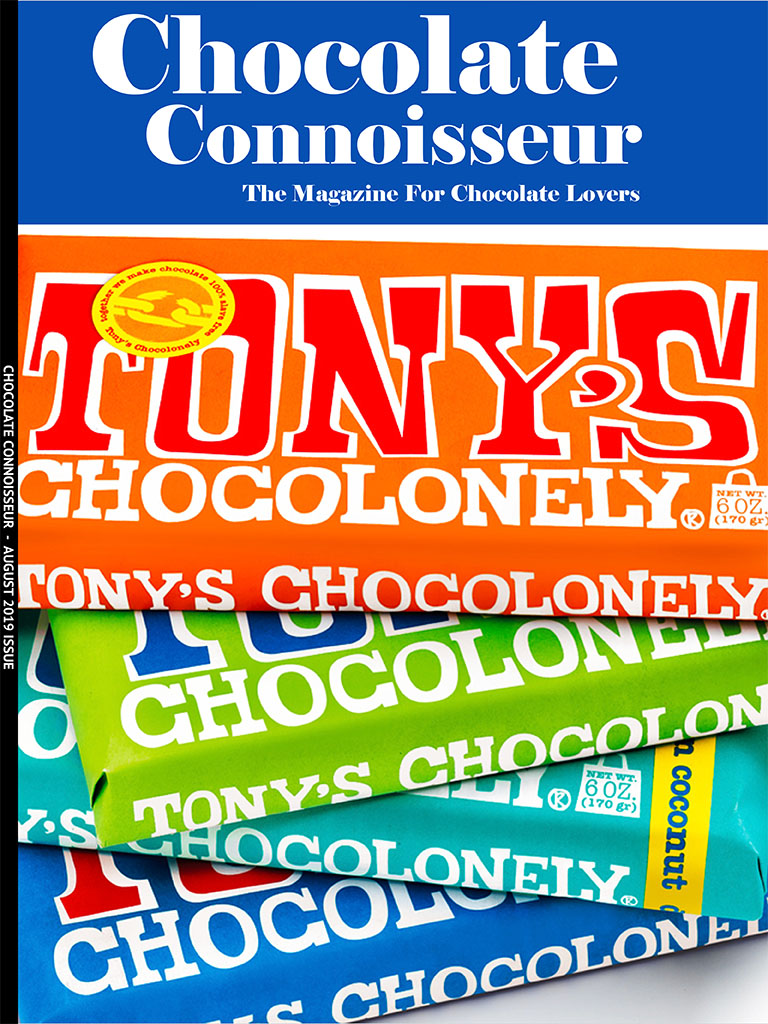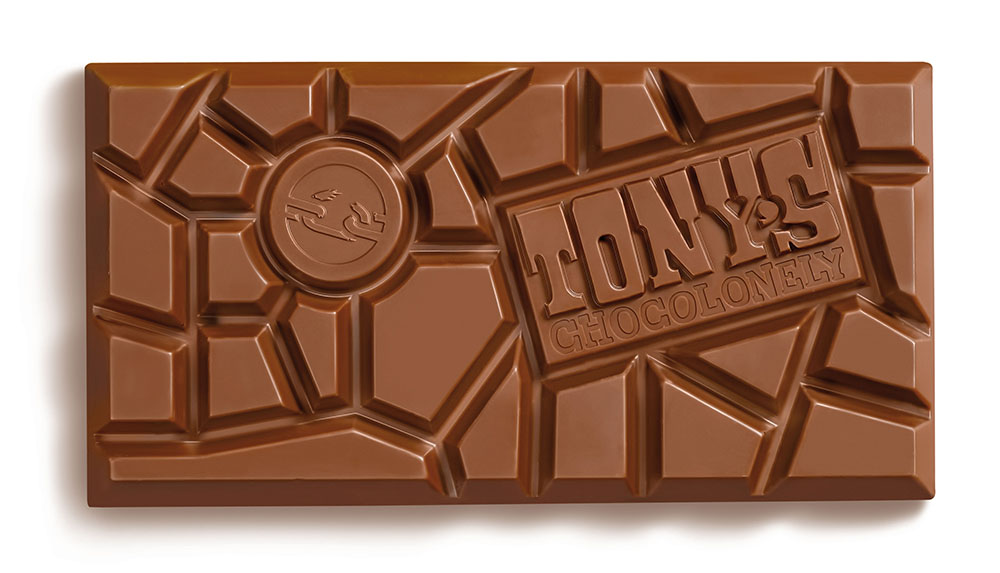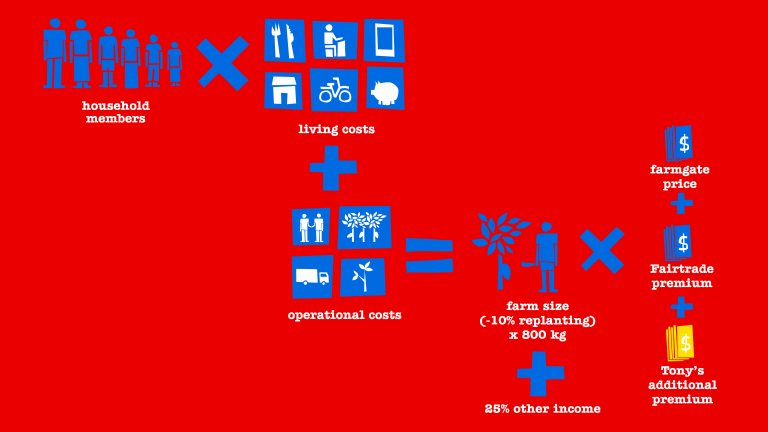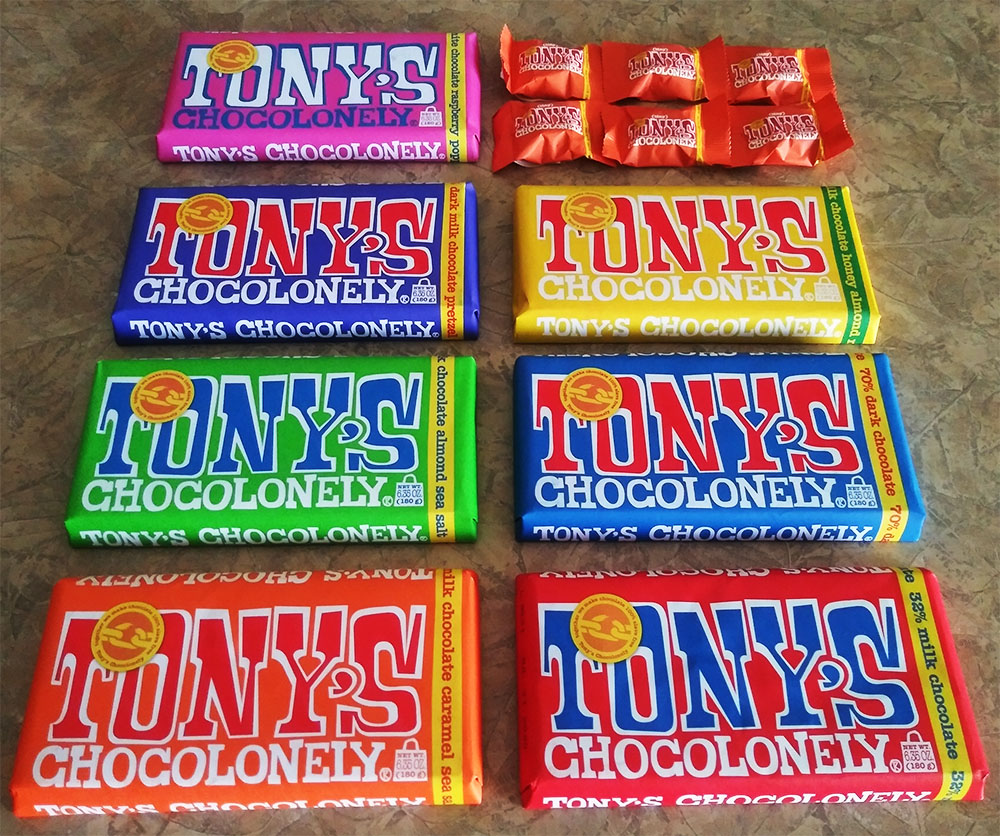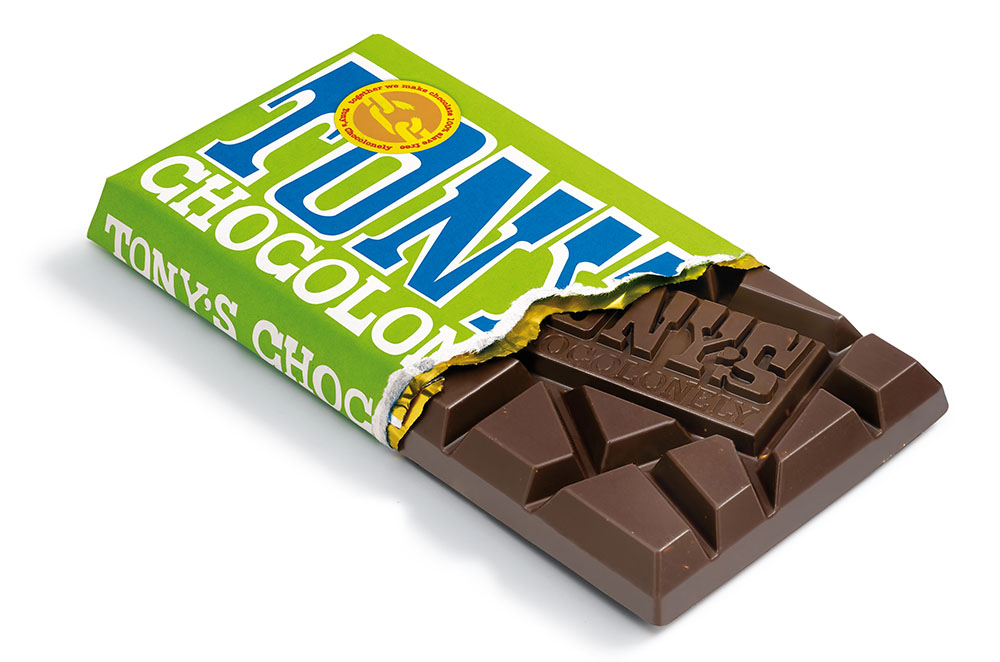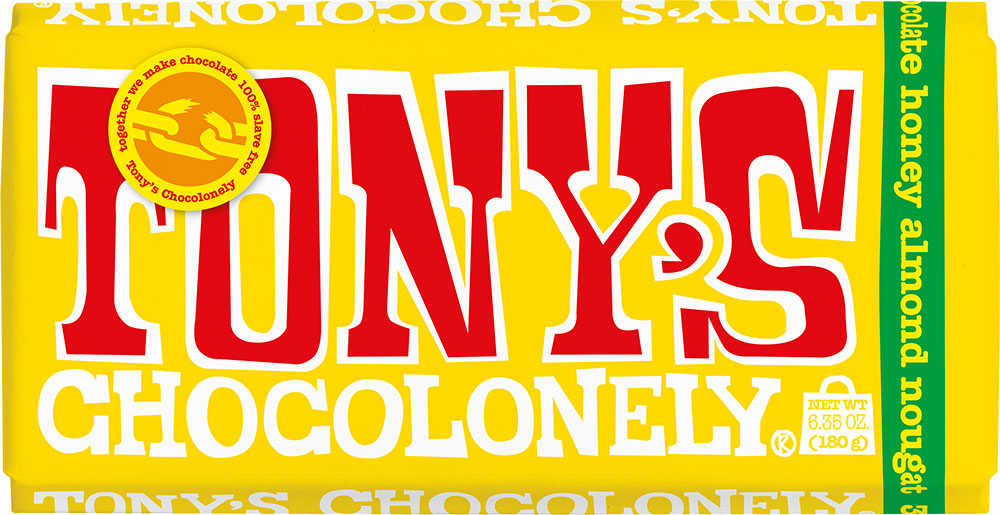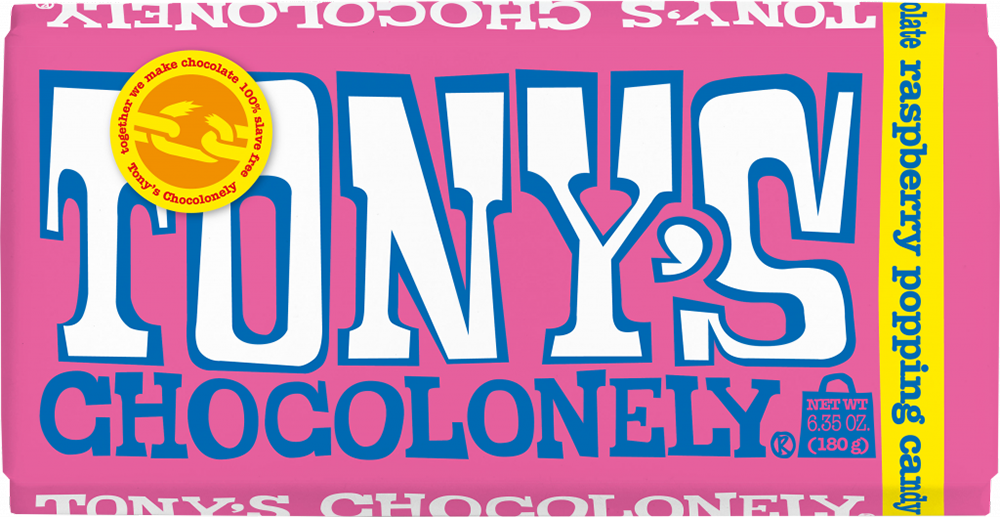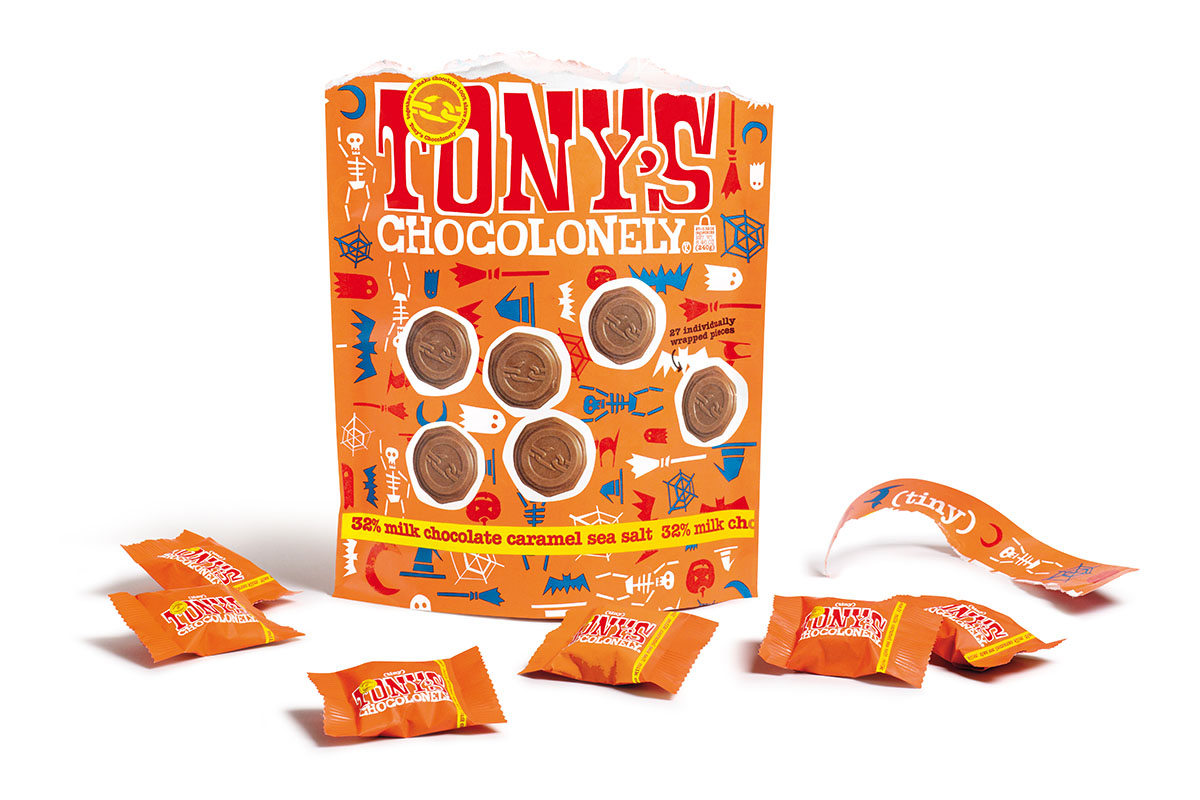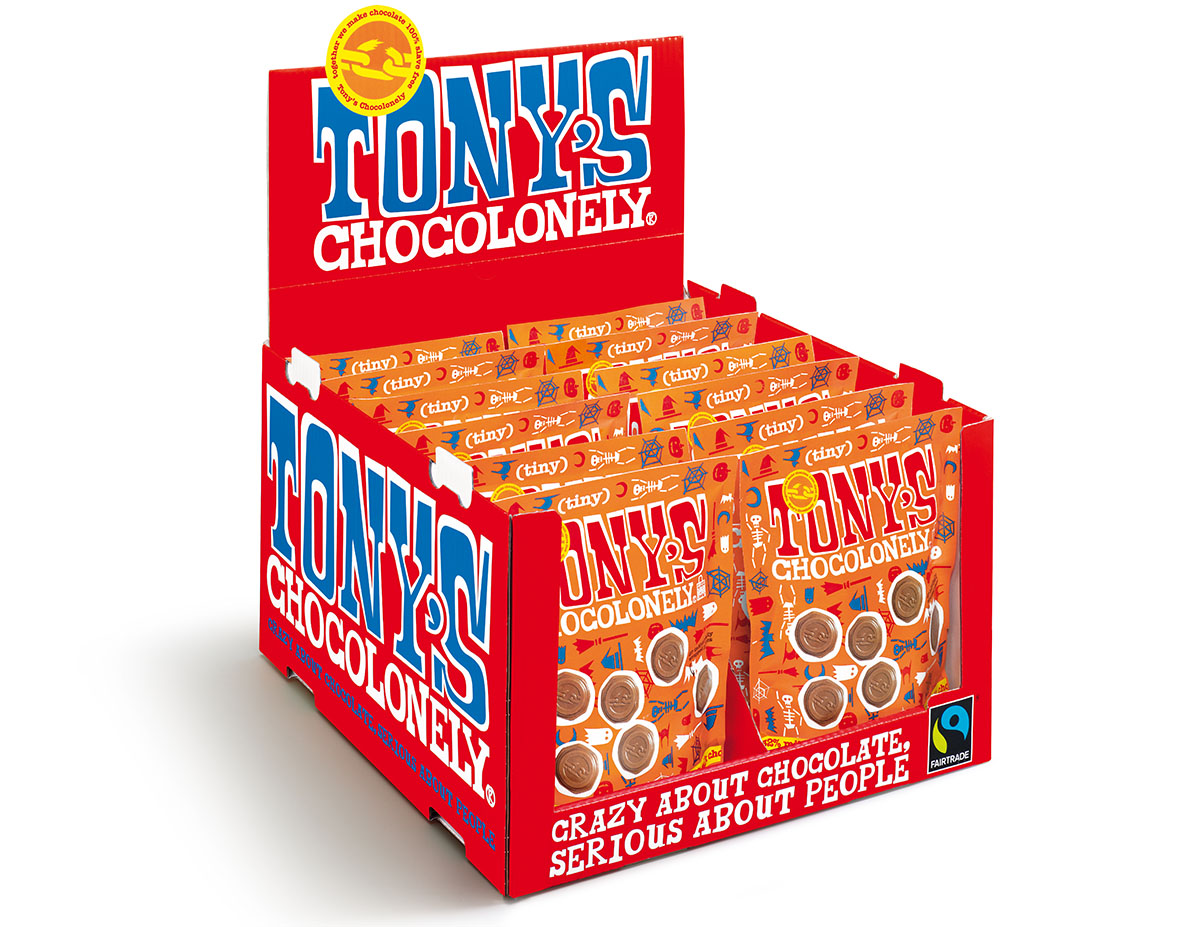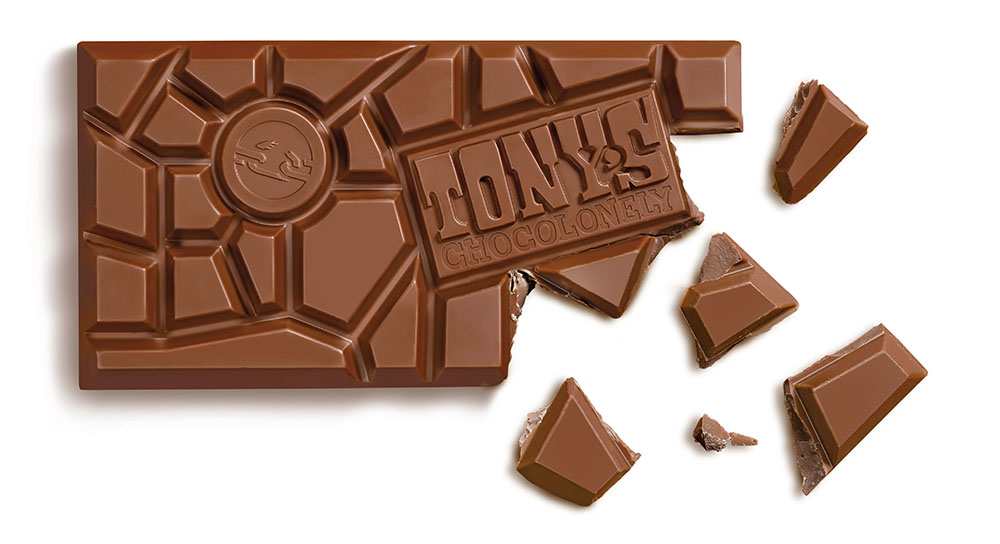On the Chocolate Regluar: Tony’s Chocolonely
by Eric Battersby
Back in early 2017, shortly after we rebooted Chocolate Connoisseur Magazine, our Associate Writer Marisa Mudge opened the door for an article on Tony’s Chocolonely, a company who, at the time, only recently took the plunge into the USA chocolate market. She’d been in contact with the company’s fledgling American operation, and, with their important mission, we were both excited to learn more.
At that point, I’d never even seen a Tony’s Chocolonely bar on a store shelf.
They were busy expanding in the states… we were busy re-building Chocolate Connoisseur… it was a crazy time, and we never did quite connect to cover Tony’s Chocolonely.
Alas, here in the summer of 2019, Tony’s reached out to us, asking if we’d be interested in covering the two newest bars in the Chocolonely lineup: White Raspberry Popping Candy and Milk Honey Almond Nougat. With extra media attention thankfully focused on the child & slave labor issue this year, I could think of no better time to finally sync up with Tony’s and put together this long overdue On the Chocolate Regular segment, so here we go!
Citizen’s Arrest
We’ve shared some wonderful stories of On the Chocolate Regular companies over the years (yes Theo and Taza, we’re looking at you), but I’m not sure if anything compares to the intense, powerful journey Teun van de Keuken undertook to reach the status of slave-free chocolate maker.
Way back in 2003, a mere two years after several large chocolate makers signed the infamous (and sadly ineffective) Harkin-Engel Protocol, seeking to eradicate “the worst forms of child labor”, Teun, at the time a journalist in Denmark, discovered the shocking truth behind chocolate labor for himself.
According to the Tony’s website, upon learning of this travesty, and the commitments agreed to in Harkin-Engel, Teun called “every single chocolate maker in the world, but nobody would talk to him.”
Now that might be a tad exaggerated (although back then there were certainly much fewer chocolate makers), but I think it’s a fair assumption that he, at the very least, called every single chocolate company associated with Harkin-Engel. Regardless of semantics, with a terrible problem confronting our world’s chocolate supply chain, Teun took decisive action.
As part of a television program called Keuringsdienst van Waarde, on which “journalists revealed some of the dark secrets behind the production of our food and goods”, Teun decided to make one episode particularly memorable… an episode which, probably unbeknownst to him at the time, served as the unofficial dawn of Tony’s Chocolonely.
In the episode, “he ate a pile of chocolate bars and turned himself in as a chocolate criminal to the Dutch authorities.”
Although it was a near perfect awareness and publicity ploy for the plight of African children in child labor, the initial end result offered no real surprise or drama, as the public prosecutor refused to bring charges against Teun. Undeterred, however, he then sought out some actual victims of his chocolate binge, to prove he had indeed actually committed a crime.
Here’s a very short video from some of those “witnesses”:
This new tactic forced action by the court of justice, although a final verdict wouldn’t come through for another three years (more on that in a moment). In the meantime, in 2005, Teun decided to take matters into his own hands. First, he approached Nestlé, asking if they would be interested in producing a slave-free chocolate bar.
When they, of course, declined that awareness-raising but profits-killing endeavor, Teun then instead led by example, crafting his own chocolate in November of that same year – the very first Tony’s Chocolonely bar (see picture below).
Purposefully packaged in an alarm-raising red wrapper, Teun proclaimed the bar to be Fairtrade and ‘100% slave-free’. When 13,000 chocolate bars sold, a movement was officially underway!
Finally, in 2007, the day of chocolate reckoning finally arrived for Teun after his fabled, public chocolate binge on the Keuringsdienst van Waarde show, as the court of justice offered its final decision –
“The outcome is quite disappointing: Teun wins a moral victory in his case against himself as a chocolate criminal, but the court won’t prosecute him. If it did, it would have to prosecute everyone who eats chocolate. Not long after, the Keuringsdienst van Waarde airs its final episode on the abuses in the chocolate industry.”
A New Level of Adversity
And 2007 delivered more disappointments than simply the weak chocolate verdict. Swiss chocolate company Bellissimo took legal action against Tony’s, proclaiming that ‘slave-free chocolate doesn’t exist’, hypothesizing that Ton’y slave-free claim unfairly, and inaccurately, harmed other chocolate makers.
The judge decided in Tony’s favor, but upon a visit to Ghana, Teun learned that a Fairtrade certification unfortunately does not guarantee slave-free production. Tony’s then changed their signature “100% slave-free” motto to “on our way to 100% slave-free chocolate”.
Recognizing an even bigger gap than he initially feared, Teun and his company created The Chocolonely Foundation the following year. Funded from chocolate sales, the company “donates 1% of its net revenue to projects aimed at creating a slave-free chocolate industry.”
Clearly, the slave-free mission had a long way to go, even twelve years ago, and Tony’s showed no signs of slowing down. In 2009, the company launched the ‘Tony’s in Africa’ research project, with financial support from Oxfam Novib –
“Tony’s examines the supply chain, researches possible options for improving it, travels to cocoa farms in Africa and engages in dialogues with the farmers and cooperatives. Based on the results Tony’s decides, for the time being, to purchase Fairtrade cocoa according to the Mass Balance principle.”
If this is the first you’re hearing of the Mass Balance principle, here’s a clear definition of the concept, as noted on the Flocert website –
“Mass Balance is the practice in Fairtrade which requires certified companies to ensure that the amount of outputs sold as Fairtrade must be equivalent to the amount of inputs sourced as Fairtrade, taking into account production yields and losses.
The quantity of products or ingredients sold must not exceed the quantity purchased, therefore ensuring that the “balance” is positive. Mass Balance is only applicable to a few Fairtrade products (cocoa, cane sugar, juice and tea, as well as the FSP Cotton and Gold Sourcing Programs).”
This wise decision helped bring Tony’s a notch closer to their slave-free chocolate goal, but a year later, one mostly fair criticism of the company surfaced (one we’ll touch on later in this article as well) – a slave-free chocolate goal is great, but chocolate bars contain more than simply cacao.
In 2010, Tony’s launched a new Hazelnut Milk Bar, and that aforementioned criticism hit home hard when the Dutch TV show Een Vandaag chastised Tony’s for using child labor-produced hazelnuts from Turkey. Recognizing the sharp conflict with their own values, Tony’s quickly switched their hazelnut sourcing to a Dutch producer.
Raising Inequality Awareness in Every Single Bar
In 2012, while launching several new products (including an organic chocolate milk), Tony’s also made the conscious decision to change the pattern on their chocolate bars to the now famous, unequally-divided sections we’ve all grown accustomed to. Here’s a short video explaining why –
The following year, Tony’s took another big step forward, crafting their first bean to bar chocolate, with cocoa mass “fully traceable and manufactured by farmers that Tony’s knows personally.”
2014 saw arguably an even bigger leap, as Tony’s began “paying cocoa farmers a Tony’s premium in addition to the Fairtrade premium” –
“[Tony’s started] paying cocoa farmers 25% more than the standard price they receive for their cocoa. This is based on the findings of a study by True Price, which calculated the amount cocoa farmers needed to be paid in order to receive a living income.”
They also expanded their reach into Finland and Belgium, and then a year later, Tony’s also stretched over to the USA –
“We celebrate our tenth birthday and because of our enormous growth over the last ten years we start a partnership with a third cooperative in Ghana. This increases our impact to 1,200 farmers.
We need to grow more to have a bigger impact, so Tony’s goes to the U.S.A., starting in Portland Oregon.”
NOTE: For a look at their fun promo video on the big USA expansion a few years back, make sure you catch this issue’s Chocolate Channel.
Finally, as we reported on here in the magazine quite some time ago, in 2016 Tony’s installed their own cocoa butter tank at Barry Callebaut, marking their ability to fully trace all of their cocoa butter.
“So every cocoa bean in a Tony’s chocolate bar is traceable and has been directly purchased from one of our partner cooperatives in Ghana and Ivory Coast.”
With that structure firmly in place, Tony’s restarts white chocolate production once again, officially re-launching the white chocolate with raspberry popping candy bar, which only recently hit the U.S.
Tony’s Today
As Tony’s continued to progress, seeking greater impact on the child labor and slavery crisis, they created their “5 Rules of the Game for Slave-Free Cocoa.” You can read much more about this on Tony’s extensive and truly wonderful website, which is a must-visit that we’ll discuss a bit more later, but for now, let’s dive into the basics. Here’s the introduction –
“Over the last few years we’ve been working on Tony’s Chocolonely’s rules of the game for slave-free cocoa. At this point we are confident that it enables cocoa farmers to earn a living income. And that will put an end to slavery and child labor on cocoa farms in West Africa.
Our rules of the game for slave-free cocoa [are] based on 5 sourcing principles. We believe that all chocolate companies should apply these principles to their relationship with cocoa farmers. And – this is very important – the rules will only work if you use all of the principles together. So, picking out 2 or 3 and doing your own thing is not an option. You gotta stick to all 5, otherwise it just won’t work.”
Those five rules are simple, straightforward, yet quite powerful: Traceable Beans, Higher Price, Strong Farmers, The Long Term, Better Quality, and Productivity. Let’s take a look…
Traceable Beans
Tony’s ensures all of their cacao beans, whether used for cocoa mass or cocoa butter, are fully traceable. They purchase their beans directly from their partner cooperatives Kapatchiva, Ecojad, Socoopacdi and ECAM in the Ivory Coast, as well as ABOCFA in Ghana.
According to Tony’s, by working together, the members of their partner cooperatives “have steadily increased their cocoa production since we first started all of this.” They also note that such growth requires “adequate planning and accurate estimations of the amount of required beans.
The company employs their official “Beantracker” to accurately track bean transport, knowing precisely where their beans come from, and when they will arrive — because without traceable beans for any chocolate maker, it’s game over on the slave-free front.
Higher Price
This element to Tony’s own strategy is absolutely huge. For all the work and diligence required to eradicate chocolate labor issues in Africa, the price paid (and the minumum required to be paid) stands tall above all else. Here’s Tony’s take –
“We pay an additional premium for our cocoa because the price that farmers usually get paid for their cocoa (the farmgate price) makes it impossible for them to escape the poverty gap. They don’t even earn enough to cover their expenses. The Tony’s premium makes up the difference. We believe cocoa farmers should be able to earn a living income. In other words, the net household income should provide a respectable standard of living for all members of an average-sized household.”
Thankfully, the governments of Ivory Coast and Ghana recently made significant progress on this front, with both countries raising their farmgate prices at different times over the past few months. As Reuters recently reported –
“Ghana and Ivory Coast joined forces in June to impose a floor price for cocoa of $2,600 per tonne and a live income differential (LID) of $400 per tonne. They have also been in talks for two years about simultaneously announcing their farmgate prices.
The two countries are also working together to set prices close enough to avoid cocoa smuggling on their border.”
Tony’s has had their finger on the price pulse of chocolate for over a decade now, so to see this sort of progress will most certainly bring smiles to everyone’s Chocolonely faces! We’re getting there! Also, on their website, Tony’ dives into great detail on premium pricing, living wage requirements, etc., so feel free to read all the details there (links at end of article) after you’re finished here.
A detailed breakdown of how Fairtrade falls short…
Strong Farmers
In a practice very common in smaller, bean-to-bar chocolate makers, Tony’s also invests in the cooperatives they partner with, putting their money where their mouth is to help strengthen farmers.
“We help to make them stronger. We show them how to operate more professionally as an organization, help them achieve economies of scale and create commitment and trust amongst the farmers. Strong cooperatives offer many benefits for farmers. For instance, they can negotiate a better price when buying production resources collectively.”
Tony’s also holds annual general meetings in both Ghana and Ivory Coast, “so we can get to know the farmers even better and see that our premium is being put to good use.”
The Long Term
It sounds incredibly intuitive, yet I’ll venture a guess that you’ve rarely heard this part of farmer-chocolate maker relations discussed. Tony’s pledges to work with any farmer they partner with for at least five years.
Why?
“That way they know they’ll receive the Tony’s premium for their harvest for the next few years. That gives them the opportunity to make long-term investments in their farms. For example, they can buy new cocoa plants for a better harvest… or invest in farming equipment or training.
As a result of our long-term relationship, we see that the farmers are now more aware of the consequences of child labor… Before we can start talking about eliminating child labor or slavery, it’s necessary to create supportive conditions in the community.”
Yes, it makes perfect sense, but this is one area in which smaller chocolate makers may find it difficult to keep up, particularly in the early stages of their businesses. I recently discussed this situation with Goodnow Farms Chocolate’s Tom Rogan, as it’s something he’s very passionate about as well. The more stability chocolate companies can provide for their farming communities, the easier the road to slave-free will become.
Better Quality and Productivity
Finally, Tony’s completes their five pillars with better quality and productivity from the farmers. At first glance, this may strike you as a bit of greed on the company’s part (make us more chocolate!), but in truth, they’re simply striving for greater farmer success. Tony’s wants to see farmers not only paid more, but producing more.
“A good farmer supported by a professional cooperative that achieves economies of scale, should be able to produce 800 kilos of cocoa per hectare. Yet many farmers only produce 30% to 40% of what we think should be possible.”
Why is this such an important piece to this puzzle? Because when farmers produce at only thirty to forty percent capacity, they miss out on income; plus, this low percentage often points to lower quality beans as well, which can negatively affect income to an even greater extent.
Tony’s explains further –
“The Tony’s premium encourages farmers to improve their crop. As their farms become more profitable their motivation increases. A win-win! It also enables them to invest in production resources, like better fertilizer, in pruning their trees at the right time and planting new cocoa trees.
This increases the quality of their beans and can double their productivity. Of course, we’re realistic enough to realize that while this can happen relatively quickly, it doesn’t happen overnight. That’s why we work with farmers for at least 5 years.
In short, motivated farmers with basic training and a willingness to cooperate and invest more time in their farms can easily harvest 800 kilos per hectare versus the 350 to 550 kilos they currently harvest.”
Tony’s Five Rules of the Game sound quite intuitive once you’ve read them, but if they were put into place by every chocolate maker on the planet, we’d likely see child slavery and labor decimated much more quickly.
Here at Chocolate Connoisseur, we applaud Teun for his courage in starting this movement, and of course we applaud everyone at Tony’s Chocolonely for working diligently to right a very egregious wrong in our world today. Much love, Tony’s. Much love.
Now… let’s try some chocolate!
All the Colors of the Rainbow
As we noted earlier, when Tony’s first began, they chose a bright red wrapper as a metaphorical alarm for the injustice the company sought to combat. One color wrapper, however, grows a tad stale (and counter-productive as well I’m sure) when it’s time to develop new chocolate bar varieties.
In keeping with both their positive message and an attention-grabbing desire for their important cause, Tony’s keeps every single bar a loud, colorful design, one that you won’t easily ignore (and of course, producing 6+ ounces bars also helps)! Rich colors and pastels really help Tony’s stand out on store shelves.
They currently offer nine core big bars, with drastic differences in cacao content. The three bars I pick up when the Chocolonely mood strikes me are the 70% Dark Chocolate, the 51% Dark Almond Sea Salt, and my favorite, the 51% Dark Pecan Coconut, which says something, since I don’t particularly enjoy pecans (but I do love me some chocolate and coconut)!
The Fog is Getting Thicker…
For this article, Tony’s sent over a TON of chocolate, which although of course much, much appreciated, presents a unique problem for yours truly. Here at Chocolate Connoisseur, other than the three bars noted above, we consider Tony’s bars to fit snugly into the candy bar category moreso than the chocolate bar category. Higher sugar content and of course the resulting higher carbohydrate content make these bars dangerous, particularly for sweets lovers like myself, who avoid large quantities of anything sweet.
I can, for the most part, make a dark chocolate bar last across three to four snack sessions. Tony’s bars, however, don’t last long, which is a problem since they are so large to boot! In other words, if Eric isn’t getting larger (pardon the Airplane! movie references here) by the time this issue publishes, it will be a small, sweet chocolate miracle.
The things I do for our readers…
Alright first off, here are the bars Tony’s sent over, photo included:
- Dark Chocolate 70%
- Dark Almond Sea Salt 51%
- Dark Milk Pretzel Toffee 42%
- Milk Caramel Sea Salt 32%
- Milk Chocolate 32%
- Milk Honey Almond Nougat 32%
- White Raspberry Popping Candy 28%
They also sent over their new milk caramel sea salt 32% Halloween Tiny Tony’s, a new player in the Halloween candy scene that we hope can at least make a small dent in big chocolate’s stake this Halloween season (more on that in a bit).
Tasting Time
First, I jumped right into my second favorite bar, the Dark Almond Sea Salt 51%. I love this bar, and although it tastes saltier to me than the salt content indicated on the label, I actually don’t mind the intense saltiness, for two reasons.
First, it fits very well into the flavor profile, and second, it keeps me from overeating this bar (much appreciated, thank you Tony’s). Again, this is one of the three bars I’d recommend for mid-level or master connoisseurs, and it’s a great OTCR bar for newer connoisseurs.
Next up, Tony’s highest quality bar, the Dark Chocolate 70%. With only four ingredients, this bar scores the highest quality-wise: cocoa mass, sugar, cocoa butter, and soy lecitihin.
Dark Chocolate Almond Sea Salt
I enjoy this bar, another great entry for those of you fitting into the categories I noted for the Dark Almond Sea Salt 51%. Also the one bar with enough subtlety for tasting notes, which for my palate registered as zinfandel and honey. It’s quite a tasty 70% bar, but for me leaves a mild aftertaste – again, something I don’t mind with these bars, however, because it prevents me downing 6 ounces in two sittings!
Next, it’s the Dark Milk Pretzel Toffee 42% bar, or as I like to call it, The Devastator. Make no mistake, this is a candy bar, and my god is it a delicious one. I’ve tried it before, so I already knew full well to take only one bite… that’s all you need. For new connoisseurs trying to figure out how to move on from the likes of Twix bars and Reese’s Peanut Butter Cups, try this bar. Just don’t expect it to last long if you too have a sweet tooth. In my humble opinion, it’s a near perfect candy bar.
With my willpower tested to its fullest, I’m riding that successful momentum into the other potentially binge-tempting bar, the Milk Caramel Sea Salt 32%. This super sweet and super salty confection tastes wonferful, again, recognizing that you’re eating a candy bar here much more so than a chocolate bar.
Similar to the dark chocolate almond sea salt bar above, the deep saltiness does indeed help curb any desire to eat way too much of it, so for a 32% bar, I can actually stretch this one out thankfully. The 10% less cacao content, coupled with caramel instead of almonds, adds much more sweetness as well, so this bar will taste incredible if sweet and salty is your thing.
Now it’s time for the bar that started it all, Tony’s original Milk Chocolate 32%, a bar I haven’t sampled in quite some time now. I realize this won’t make any Tony’s Chocolonely marketing materials, but my favorite way to describe this bar is “What Hershey’s would taste like if they didn’t suck.”
Again, make no mistake, this is a candy bar, even with no inclusions. The first two ingredients are sugar and whole milk, followed by cocoa butter, and then cocoa mass only registering as the fourth most prominent ingredient (and soy lecithin then bringing up the rear). Say what you will, the bar is milky and delicious, one of the more dangerous binge-able bars for someone like me.
This bar, like all of Tony’s 42% cacao and lower lineup, fits perfectly into the introductory OTCR category of bars for aspiring connoisseurs. They’re all great bridges to higher chocolate connoisseur levels, and we certainly recommend them for this specific niche, especially considering the phenomenal work Tony’s does to help make the world a better place as well.
Two bites, oh-so-slowly savored, and now it’s on to the newness…
Two Sweet
Here we go, the two new bars (at least here in the U.S.) that inspired this entire OTCR article in the first place – milk honey almond nougat 32% and white raspberry popping candy 28%.
Let’s start with the milk honey almond nougat 32%. I think it’s safe to say Tony’s now wholeheartedly embraces the candy bar aspect of their business model, as these new bars easily hits that home the hardest of any I’ve tasted to date.
The milk honey almond nougat here, with 15g of sugar per serving (second only to the milk caramel sea salt 32%), is incredibly sweet. Indeed, for my palate, despite one less sugar gram, the bar actually tastes a bit SWEETER than the milk caramel sea salt.
Don’t get me wrong, however, as it tastes wonderful for what it is, and again, the high sweetness level does indeed prevent over-eating. Two bites were plenty for me.
Finally, it’s time for the bar I teased in last issue’s Editor’s Corner as a fun bar for the kids to share on summer road trips – Tony’s white raspberry popping candy 28%. As a sucker for both white chocolate AND raspberry inclusions, this bar worried me as I carefully unsealed the bright pink and summery wrapper.
It’s the only bar in Tony’s entire big bar lineup with no cocoa mass, only cocoa butter (the second ingredient behind sugar). And yes, you can taste that difference. Easily the sweetest-tasting bar, with 17 carbs and 16 sugar grams per serving, you’re looking at a pure candy bar here folks – not that you’d expect otherwise from a bar that indicates “popping candy” in the name!
Only those with the deepest of sweet tooths will appreciate this bar, for although the raspberry flavor works very well, nothing can temper the overwhelming sweetness. If you’re a big raspberry and white chocolate fan with a love for sugar to boot, this may very well be your all-time favorite Tony’s Chocolonely bar. For me, it’s the only Tony’s bar that actually overwhelmed my sweet tooth.
An Anti-Slavery Halloween Curveball
Every single Halloween for several years, I begrudgingly buy a giant bag of big chocolate’s candy to hand out to trick-or-treaters, and I’m less and less happy about it each and every year. Finally, here in 2019, Tony’ Chocolonely comes to the rescue!
Sent in a separate box, with two handwritten notes, Tony’s foray into the ultra-competitive Halloween scene immediately impressed. The deep orange packaging with a yellow bar at the bottom, mirroring the big bar version of the candy inside (32% Milk Chocolate Caramel Sea Salt), perfectly fits the season’s color motif.
The candy choice is also probably the perfect choice for starters, as its sugar content and taste very closely match the Halloween kingpin, Reese’s Peanut Butter Cups. Yes, less sugar would be nice, but let’s keep it real here folks – it’s Halloween. Baby steps, baby steps.
As you can see in the picture here, a broken chain serves as the chocolate graphic, but it’s what you can’t see that’s even better. First, the outer packaging is recyclable paper. Second, the individual wrappers are recyclable plastic! While it’s true that recylcable plastic is nowhere near as ideal as recyclable paper, the current plastic wrapper waste from Halloween chocolate wrappers is immeasurable (including the big bags the candy sells in). Tony’s can make a significant impact with each bag of candy they sell this year and onward.
Make Halloween 2019 much less hypocritical… find this box!
Big props to Tony’s Chocolonely for jumping into the Halloween candy fray. I’m so impressed that they made the effort here, and I can’t think of a more synchronous step than offering child slave-free chocolate to children on Halloween. We wish them great success this year, and hope this leads to significantly more attention brought to the plight of our chocolate supply chain this holiday.
What Lies Ahead…?
I very much look forward to seeing whatever big leap of progress Tony’s makes next in their efforts to eradicate slavery in chocolate. While plenty of inspirational chocolate makers exist today, few if any volunteered to spend time behind bars to make a point… to elevate the fight against child labor and slavery to a whole new level.
As we all do our part to raise awareness, make more and more noise, and put our money where our mouths are, progress will continue. I’m excited to celebrate with Tony’s when the slave-free day finally arrives, and I truly believe we can eventually reach that day.
On the chocolate ingredients front, although Tony’s does a bang up job of sourcing their cacao and their sugar from fair trade sources, the Fairtrade standards they meet vary between bars, which we’re guessing is more a product of the sugar sourcing than it is the cacao sourcing. That is, of course, an area where we’d like to see them improve. Cane sugar tends to be the issue, and as a preferred sugar source over beet sugar for most, it needs the fairtrade certification more thanks to its production origins, whereas the majority of the world’s beet sugar, particularly non-GMO beet sugar, grows in the EU.
We reached out to Tony’s for clarification on their sugar, and in their official response, they noted that they use “a mix of Fairtrade mass balance cane sugar and beet sugar.” Essentially, if you don’t mind eating beet sugar, you should find no issue with Tony’s chocolate.
Finally, our one big concern lies with the sugar, dairy, and soy products contained in several of Tony’s bars for a more specific reason — the question of organic and GMO-free. While we do often see cacao not certified organic, particularly when great direct trade relationships exist between chocolate makers and small farmers (where organic certification may prove difficult), we do not see such barriers in place for sugar, soy, and dairy.
Here in the USA particularly, the GMO controversy plays a part as well, but to a much lesser extent throughout Europe, where of course Tony’s is based. Again, we reached out for clarification, asking if a non-GMO certification lay ahead for the company. They responded with this…
Contractually (as per our agreement with Barry Callebaut), we buy only non-GMO ingredients (including the soy lecithin), but we’re not certified non-GMO. This is because Europe, where we’re based, has much more stringent guidelines around GMOs, and it’s uncommon to be certified. We don’t plan to aim for the certification either, as it would really only be applicable for the US.
That should pretty much clear up any questions on the matter. In the market they’re competing in, which is essentially the chocolate candy bar space, Tony’s takes steps you won’t find other companies even bothering with, so our philosophy is to enjoy and appreciate Tony’s for what they are. The more they can win consumers away from big chocolate, while gradually improving their own products along the way, the better the chocolate world will be.
A Closer Look + A Big “Thank You”
As we mentioned much earlier, the Tony’s Chocolonely website is fantastic, and we strongly encourage you to hop over there and take a look for yourself. Here’s a link to the U.S. version’s home page: https://tonyschocolonely.com/us/en
With a ton of great information (including much of which we used to create the article you just read here), you’ll likely pick up some new knowledge and/or inspiration from just one visit. Also, since the company now spans across several countries, you can click on the flag in the upper right corner to change website version based on countries.
Also, if you live near the Portland area or are planning a trip to that neck of the woods at some point, Tony’s offers tours if you’re interested. In fact, they just relocated to a bigger facility, so stop by and give them a look when you’re in town.
Last of all, I’d like to personally send a BIG THANK YOU not only to Tony’s for being so open and responsive as we put this article together, but also to Julia McPherson at Allison+Partners, the PR firm helping to bridge the gap between us. She helped keep things moving along from day one, and just did an absolutely fantastic job.
Also, I’d like to send a special thanks to Tony’s Portland crew who put together the not one, but two amazing boxes filled with chocolate they sent our way for preparing this article. Stay classy, Portland. Stay classy.

